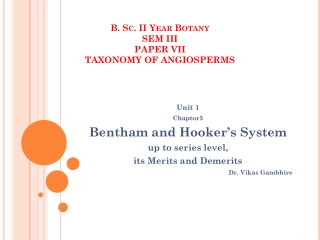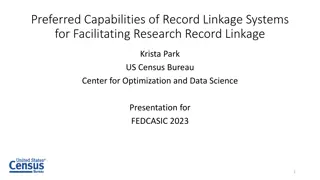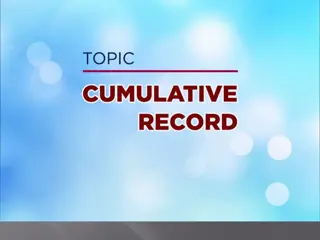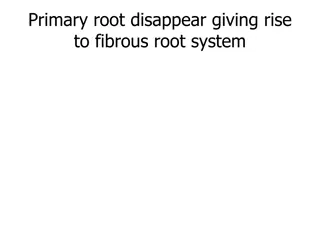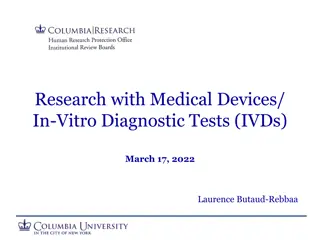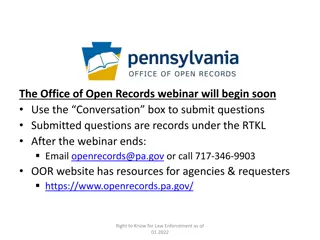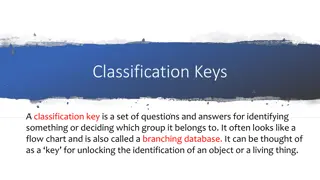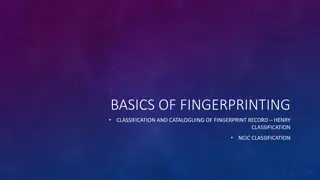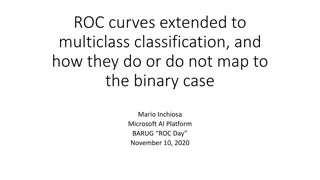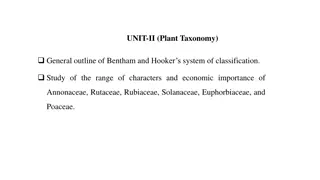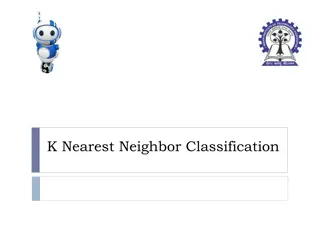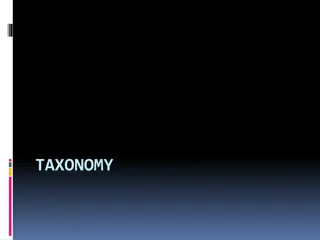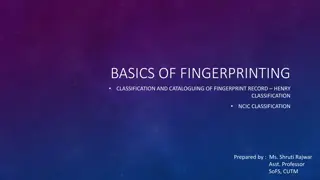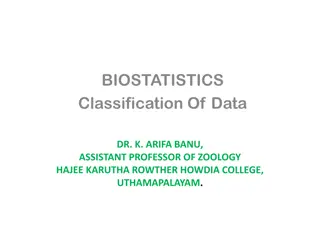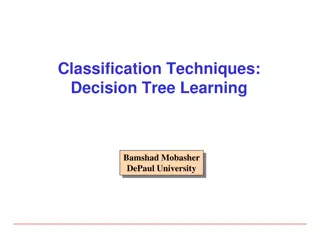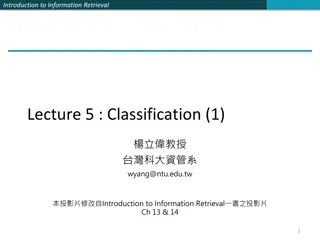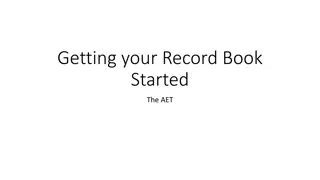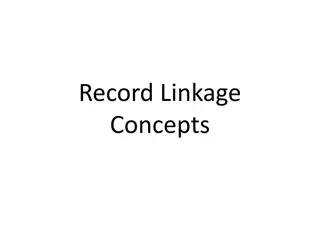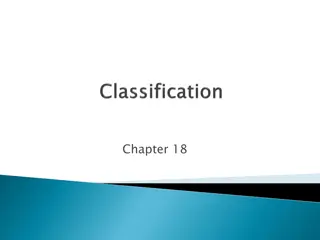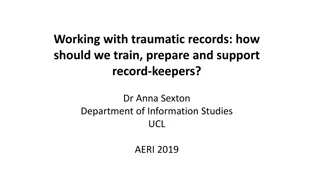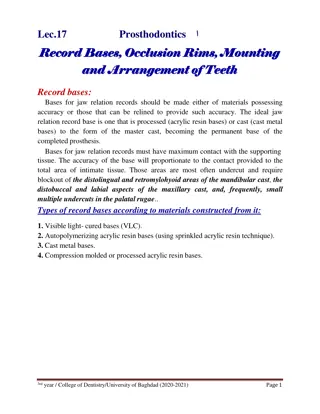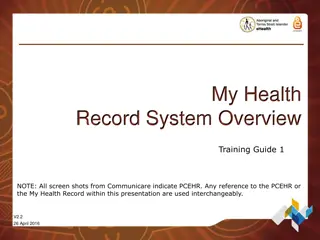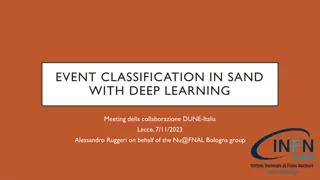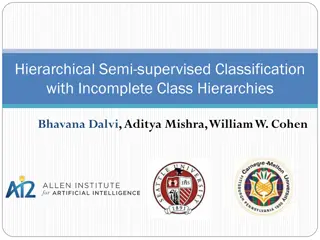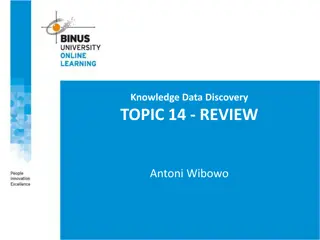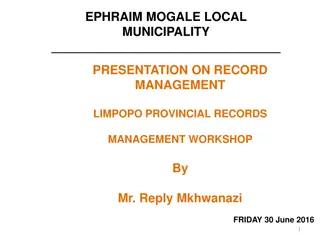Bentham and Hooker's System of Classification in Botany
Bentham and Hooker's system of classification in botany is a natural system based on a large number of characters considered simultaneously. Proposed by British taxonomists George Bentham and Joseph Dalton Hooker, this system categorizes seed plants into classes, orders, families, and genera. It is
2 views • 10 slides
Ship Classification and Design Factors Overview
Explore the categorization and classification of ships based on usage and support type. Delve into the factors influencing ship design such as size, speed, payload, range, seakeeping, maneuverability, stability, and special capabilities. Learn about the various methods of ship classification, includ
6 views • 104 slides
Understanding Tumor Classification and Nomenclature in Pathology
This slideshow provides an overview of tumor classification, nomenclature, and key concepts in pathology. It covers the definitions of neoplasm, tumor, and oncology, the classification of tumors into benign and malignant categories, as well as the importance of stroma in tumor behavior. It also expl
2 views • 61 slides
Preferred Capabilities of Record Linkage Systems for Research
This presentation by Krista Park from the US Census Bureau explores the preferred capabilities of record linkage systems in facilitating research. It includes disclaimers, details about the researcher stakeholder team, coordination, leadership oversight, and the outline of the linkage process. The f
4 views • 17 slides
Importance of Cumulative Record Cards in Education
A Cumulative Record Card is a vital document that contains essential information about a student's academic performance, attendance, health, and more. It serves as a comprehensive record that aids in the student's development throughout their school journey and helps in addressing educational, vocat
0 views • 12 slides
Plant Classification and Nomenclature Explained
Understanding plant classification through taxonomy, identification, and naming processes. Learn about the botanical structures such as roots, venation patterns, flowers, and vascular bundles. Explore the principles of binomial nomenclature, genus, and species differentiation. Discover the diverse s
1 views • 159 slides
Understanding FDA Regulations and Medical Device Classification
The Food and Drug Administration (FDA) plays a crucial role in regulating research, manufacturing, marketing, and distribution of medical devices. Medical devices are classified based on risk and intended use, with three main categories determining regulatory pathways. The classification system help
1 views • 27 slides
Understanding Migraine: Types, Classification, and Symptoms
Migraine is a complex neurological condition characterized by severe headaches often accompanied by other symptoms. The classification of migraines includes those with and without aura, chronic migraines, and childhood periodic syndromes. Complications and disorders associated with migraines are als
2 views • 46 slides
Pennsylvania Right to Know Law Update
The Pennsylvania Right to Know Law grants public access to agency records, with agencies needing to prove when a record is not public. This update emphasizes the responsibilities of Agency Open Records Officers (AORO) and outlines prohibitions agencies must not enforce. The Right to Know obstacle co
0 views • 15 slides
Understanding Classification Keys for Identifying and Sorting Things
A classification key is a tool with questions and answers, resembling a flow chart, to identify or categorize things. It helps in unlocking the identification of objects or living things. Explore examples like the Liquorice Allsorts Challenge and Minibeast Classification Key. Also, learn how to crea
1 views • 6 slides
Basics of Fingerprinting Classification and Cataloguing
Fingerprint classification is crucial in establishing a protocol for search, filing, and comparison purposes. It provides an orderly method to transition from general to specific details. Explore the Henry Classification system and the NCIC Classification, and understand why classification is pivota
5 views • 18 slides
Five Kingdom Classification in Biology: An Overview
The five kingdom system of classification, proposed by R.H. Whittaker in 1969, categorizes living organisms into Monera, Protista, Fungi, Plantae, and Animalia based on their characteristics. Each kingdom represents a distinct group of organisms, aiding in a more scientific and natural classificatio
2 views • 7 slides
Understanding ROC Curves in Multiclass Classification
ROC curves are extended to multiclass classification to evaluate the performance of models in scenarios such as binary, multiclass, and multilabel classifications. Different metrics such as True Positive Rate (TPR), False Positive Rate (FPR), macro, weighted, and micro averages are used to analyze t
3 views • 8 slides
Understanding VSAM Logical Record Access Methods
VSAM utilizes three primary methods to find logical records - Relative Byte Address, Relative Record Number, and Key field. Relative Byte Address assigns a unique address to each record based on sequential ordering. Relative Record Number is used in RRDS datasets to access records by a numbered sequ
1 views • 35 slides
Overview of Bentham and Hooker's Classification System in Plant Taxonomy
Bentham and Hooker's system of classification in plant taxonomy, outlined in Genera Plantarum, provided detailed descriptions of families and genera based on original plant dissections. This classification system has practical value for plant identification, with keys for taxa and subdivisions for l
2 views • 47 slides
Understanding Trade Barriers and Tariff Classification
Explore the concept of trade barriers, including tariff and non-tariff barriers, their objectives, types, and classification. Learn about the benefits of tariff barriers, like discouraging imports and protecting home industries, and the classification of non-tariff barriers such as the quota system
3 views • 28 slides
Understanding Classification in Data Analysis
Classification is a key form of data analysis that involves building models to categorize data into specific classes. This process, which includes learning and prediction steps, is crucial for tasks like fraud detection, marketing, and medical diagnosis. Classification helps in making informed decis
2 views • 72 slides
AI Projects at WIPO: Text Classification Innovations
WIPO is applying artificial intelligence to enhance text classification in international patent and trademark systems. The projects involve automatic text categorization in the International Patent Classification and Nice classification for trademarks using neural networks. Challenges such as the av
2 views • 10 slides
Epic Tools for Clinical Research by Shara Power, RN, BSN, OCN
Explore Epic tools for clinical research developed by Shara Power, a skilled application developer specializing in EPIC Beacon Oncology at UIHC Healthcare Information Systems. Learn about managing research study records, investigational study medication orders, and the process for creating and using
0 views • 26 slides
Understanding Nearest Neighbor Classifiers in Machine Learning
Nearest Neighbor Classifiers are a fundamental concept in machine learning, including k-Nearest Neighbor (k-NN) Classification. This method involves assigning a test sample the majority category label of its k nearest training samples. The rule is to find the k-nearest neighbors of a record based on
0 views • 32 slides
Understanding Taxonomy and Scientific Classification
Explore the world of taxonomy and scientific classification, from the discipline of classifying organisms to assigning scientific names using binomial nomenclature. Learn the importance of italicizing scientific names, distinguish between species, and understand Linnaeus's system of classification.
0 views • 19 slides
Overview of Fingerprint Classification and Cataloguing Methods
Explore the basics of fingerprint classification, including Henry Classification and NCIC Classification systems. Learn about the importance of classification in establishing protocols for searching and comparison. Discover the components of Henry Classification, such as primary, secondary, sub-seco
1 views • 21 slides
Understanding BioStatistics: Classification of Data and Tabulation
BioStatistics involves the classification of data into groups based on common characteristics, allowing for analysis and inference. Classification organizes data into sequences, while tabulation systematically arranges data for easy comparison and analysis. This process helps simplify complex data,
0 views • 12 slides
Introduction to Decision Tree Classification Techniques
Decision tree learning is a fundamental classification method involving a 3-step process: model construction, evaluation, and use. This method uses a flow-chart-like tree structure to classify instances based on attribute tests and outcomes to determine class labels. Various classification methods,
5 views • 20 slides
Understanding Text Classification in Information Retrieval
This content delves into the concept of text classification in information retrieval, focusing on training classifiers to categorize documents into predefined classes. It discusses the formal definitions, training processes, application testing, topic classification, and provides examples of text cl
0 views • 57 slides
The AET Record Book Setup Guide
Get a comprehensive guide on setting up your record book on The AET platform, including steps for logging in, creating your profile, adding classes, managing resume information, setting objectives, adding references, and creating SAE projects for a well-rounded academic record. Follow the detailed i
0 views • 20 slides
Understanding Record Linkage Concepts
Explore the fundamentals of record linkage, also known as matching or merging, which involves combining data from different sources for the same individual. Learn about the importance of efficient and accurate duplicate detection, deterministic matching, and the challenges of variations in data betw
3 views • 20 slides
Understanding Taxonomy and Classification in Biology
Scientists use classification to group organisms logically, making it easier to study life's diversity. Taxonomy assigns universally accepted names to organisms using binomial nomenclature. Carolus Linnaeus developed this system, organizing organisms into species, genus, family, order, class, phylum
0 views • 11 slides
Supporting Record-Keepers Dealing with Traumatic Records
Understanding the impact of traumatic experiences on record-keepers is crucial in training, preparing, and supporting them. Trauma, whether singular, ongoing, or complex, can be represented in records stored in archives. The potentiality of records to carry traumatic experiences requires a thoughtfu
0 views • 15 slides
Mineral and Energy Resources Classification and Valuation in National Accounts Balance Sheets
The presentation discusses the classification and valuation of mineral and energy resources in national accounts balance sheets, focusing on the alignment between the System of Environmental-Economic Accounting (SEEA) and the System of National Accounts (SNA) frameworks. It highlights the need for a
0 views • 17 slides
Essential Concepts in Prosthodontics: Record Bases, Occlusion Rims, and Teeth Arrangement
Prosthodontics involves the meticulous construction of record bases, occlusion rims, and arrangement of teeth for prosthetic restorations. Record bases must provide accuracy and maximum contact with supporting tissues, utilizing materials like acrylic resin or cast metal. Occlusion rims play a cruci
0 views • 8 slides
Understanding 4-H Recognition and Record Keeping Models
Explore the different aspects of the 4-H recognition model including peer competition, participation, progress toward set goals, achieving standards of excellence, and cooperation. Discover how volunteers can assist in successful record-keeping experiences for youth in 4-H programs. Find out more ab
0 views • 21 slides
Understanding My Health Record System: Overview and Benefits
My Health Record System is a shared electronic health record platform introduced by the Commonwealth to securely share health information among patients and healthcare professionals. It aims to improve healthcare coordination, information availability, and quality. Benefits include reduced hospital
0 views • 19 slides
Event Classification in Sand with Deep Learning: DUNE-Italia Collaboration
Alessandro Ruggeri presents the collaboration between DUNE-Italia and Nu@FNAL Bologna group on event classification in sand using deep learning. The project involves applying machine learning to digitized STT data for event classification, with a focus on CNNs and processing workflows to extract pri
0 views • 11 slides
Hierarchical Semi-Supervised Classification with Incomplete Class Hierarchies
This research explores the challenges and solutions in semi-supervised entity classification within incomplete class hierarchies. It addresses issues related to food, animals, vegetables, mammals, reptiles, and fruits, presenting an optimized divide-and-conquer strategy. The goal is to achieve semi-
0 views • 18 slides
Understanding Classification in Data Mining
Classification in data mining involves assigning objects to predefined classes based on a training dataset with known class memberships. It is a supervised learning task where a model is learned to map attribute sets to class labels for accurate classification of unseen data. The process involves tr
0 views • 26 slides
Overview of Hutchinson and Takhtajan's Plant Classification System
Hutchinson and Takhtajan, as presented by Dr. R. P. Patil, Professor & Head of the Department of Botany at Deogiri College, Aurangabad, have contributed significantly to the field of plant classification. John Hutchinson, a renowned British botanist, introduced a classification system based on princ
0 views • 20 slides
Understanding the EPA's Ozone Advance Program and Clean Air Act
The content covers key information about the EPA's Ozone Advance Program, including the basics of ozone, the Clean Air Act requirements, designation vs. classification, classification deadlines, and marginal classification requirements. It explains the formation of ozone, the importance of reducing
0 views • 40 slides
Record Management Presentation at Ephraim Mogale Local Municipality
Presentation on record management at Ephraim Mogale Local Municipality in Limpopo, highlighting the municipality's vision, location, overview, and the importance of keeping records for historical purposes and decision-making. The presentation covers key legislative acts and regulations governing rec
1 views • 25 slides
Deep Learning for Low-Resolution Hyperspectral Satellite Image Classification
Dr. E. S. Gopi and Dr. S. Deivalakshmi propose a project at the Indian Institute of Remote Sensing to use Generative Adversarial Networks (GAN) for converting low-resolution hyperspectral images into high-resolution ones and developing a classifier for pixel-wise classification. The aim is to achiev
0 views • 25 slides
